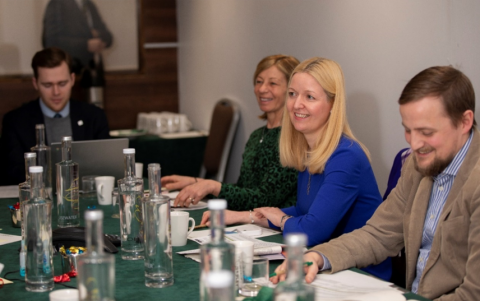Fiona (second from the right) leading a meeting of the Expert Steering Group in February 2019.
Dr Fiona Dignan is Consultant Haematologist and Clinical Director for Haematology at Manchester Royal Infirmary. She’s spent the past year working with Anthony Nolan on a new post-transplant care pathway, which describes the services and support packages that are central to patients’ recovery. In this blog she explains why she got involved, how the pathway was developed and what needs to happen next.
Why I got involved
I meet people every day whose lives have been saved by a stem cell transplant. However, I also see first-hand how physical and psychological late-effects (or ‘long-term complications’) can make recovery a real challenge.
Late-effects include graft versus host disease (GvHD), problems with the major organs, and mental health conditions such as depression. Some people have no, or only mild, late-effects, whereas for others they are severe and life-threatening. Late-effects also vary in terms of duration and fluctuate over time, with people having ‘good days’ and ‘bad days’. I know the impact on their work, home and social lives can be substantial.
Everyone should receive the care and support they need after a stem cell transplant, for as long as necessary and no matter where they live. But the reality is that post-transplant care varies across the UK.
For example, at Manchester Royal Infirmary we have both a psychotherapist and a psychologist to help patients deal with the emotional impact of a stem cell transplant. I know that many other patients aren’t so lucky, and it’s this that inspired me to work with Anthony Nolan on a new post-transplant care pathway.
Developing the pathway
There’s currently no agreed minimum standard for post-transplant care, which makes it difficult to develop and appropriately fund services that reflect patients’ needs. The post-transplant care pathway aims to fill this gap by describing the services and support packages that are central to recovery.
My role was to chair an Expert Steering Group consisting of 12 leading healthcare professionals, local NHS representatives and patients. Together, we advised Anthony Nolan on the development of the pathway – being a ‘critical friend’ when necessary! – and worked closely with them on the final report, A pathway for post-transplant care.
One of the things I’m proudest of is how we’ve involved patients, family members and healthcare professionals throughout the process. For example, between September and November 2018 we consulted on the draft pathway via a series of online surveys, focus groups and telephone interviews. We heard loud and clear what patients needed, including:
- Receiving high-quality, age appropriate information in a format that suits them. This includes information on what to expect after a stem cell transplant.
- Having access to a named key worked (often a Clinical Nurse Specialist) who is knowledgeable about stem cell transplantation, easy to contact and responsive to any questions and/or concerns.
- Being proactively offered psychological support, such as access to a peer support group, counsellor or clinical psychologist. This applies to patients’ families too.
We’ve made sure that all these things are crystal clear in the pathway, which covers everything from preparation for a stem cell transplant to long-term treatment, care and support – but our work has really just begun.
What happens next?
Now is the time for commissioners (the people who plan and pay for NHS services), healthcare professionals and charities to work together and make the pathway a reality. This isn’t going to be easy, but the Expert Steering Group and Anthony Nolan have made three recommendations to help get there:
- NHS England should publicly set out the steps it will take to ensure that patients have equal access to services that reflect their needs. Leaders in the Devolved Nations should also use the pathway to support the development of their services.
- At a local level, all those involved in planning, paying for and providing post-transplant care should review how the pathway could be used to improve and ensure the sustainability of services in their area.
- Anthony Nolan should publish an action plan by the end of 2019/20 setting out the steps it will take, in collaboration with partners, to support the implementation of the pathway across the UK. This includes ensuring that patients and their families have access to the support they need.
I believe that the pathway has the potential to bring benefit to patients, healthcare providers and commissioners alike. In the future, I hope it will help ensure that every patient can access the appropriate physical and psychological support after their transplant, wherever they live.
---
If you have any questions about the report, please email Amelia Chong, Interim Head of Policy and Public Affairs at Anthony Nolan, on PTCpathway@anthonynolan.org. For the latest news, go to anthonynolan.org/pathway
If you’re a patient or family member, you can find out about the information and support available from Anthony Nolan’s dedicated Patient Services team at anthonynolan.org/patients.
